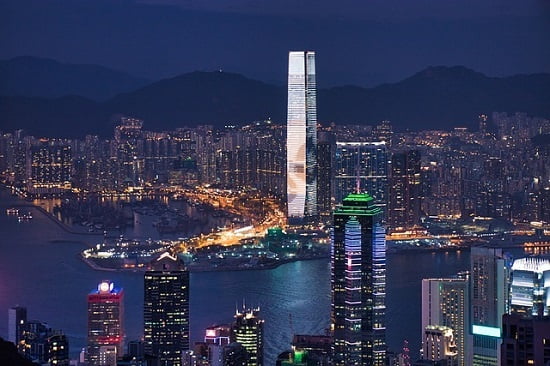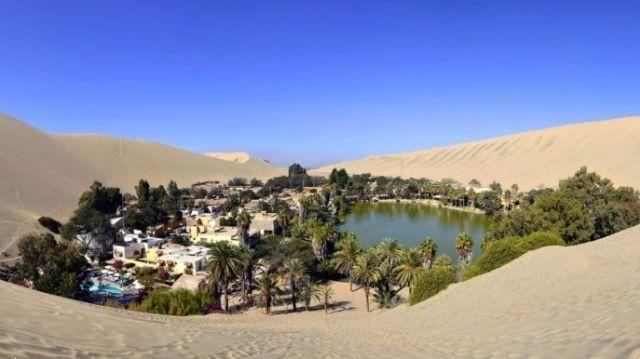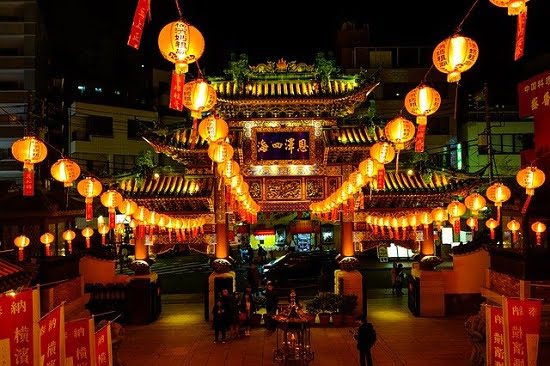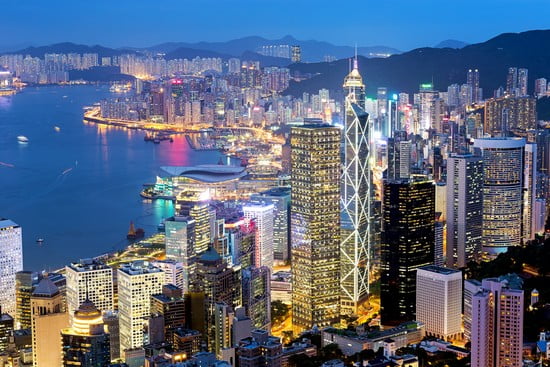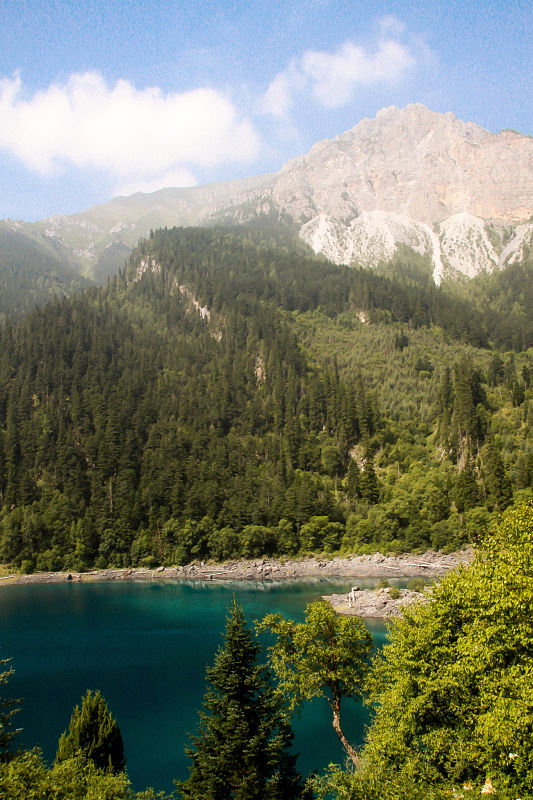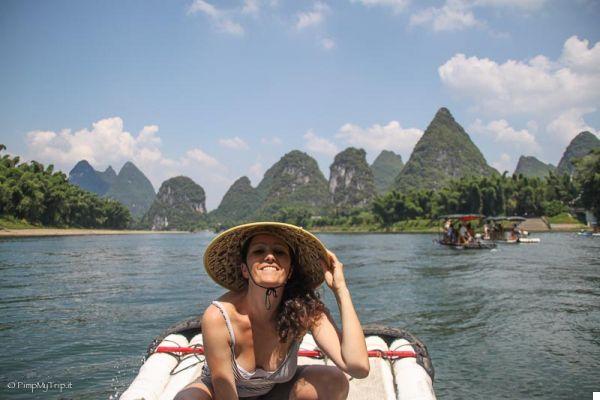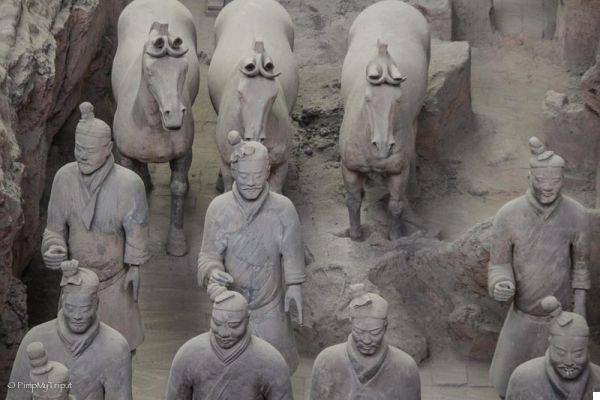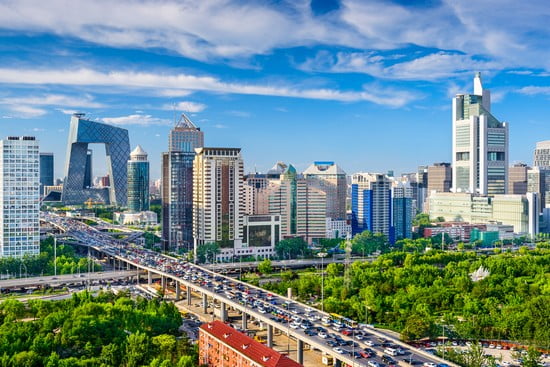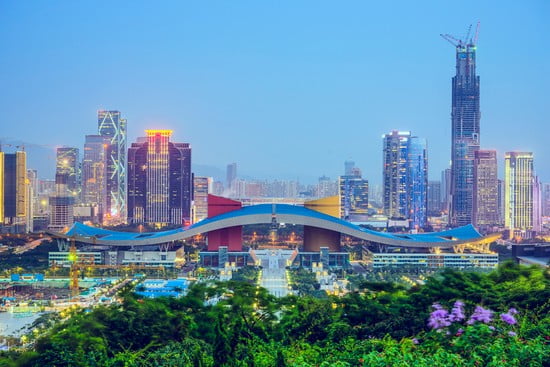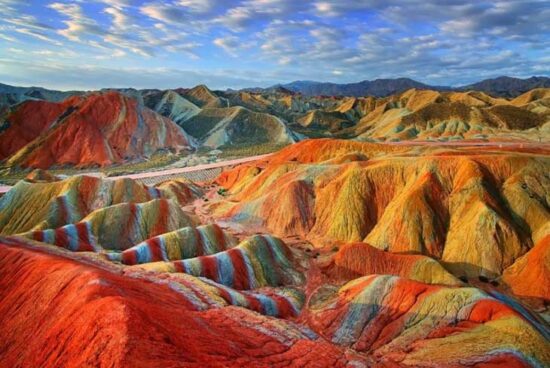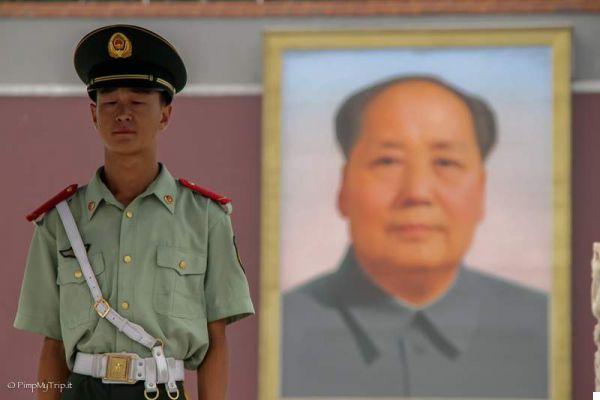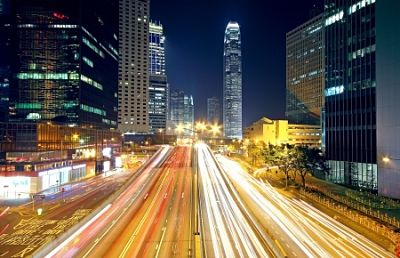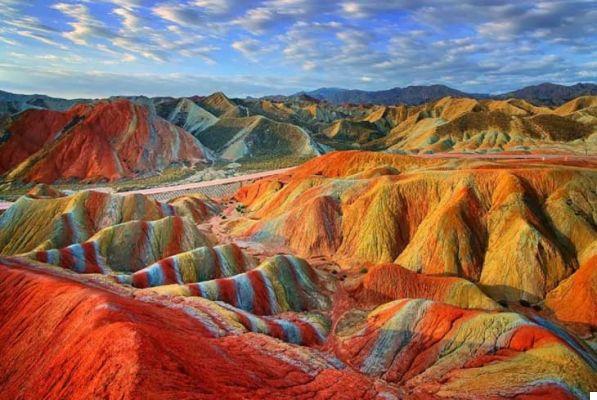La Great Wall of China (In English Great wall of china) is certainly one of the attractions not to be missed on a trip to China and with a height of up to 9 meters and more than 21000 km in length it is absolutely one of the largest wonders of the world ever built by man.
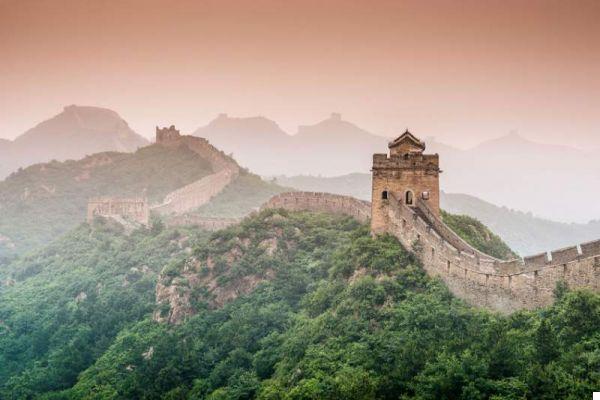
Great Wall of China
Generally the most convenient way to get to the Chinese Wall is from Beijing and even if there is not much western tourism in China yet, it goes without saying that the wall, with 10 million visitors every year, is always very crowded, as is practically every tourist area of this country.
A question then arises spontaneously: how to visit it avoiding the crowd and above all avoiding unpleasant surprises like the one that happened to me in Hua Shan?
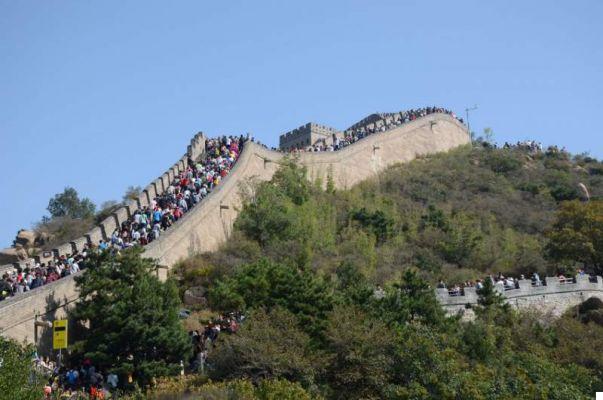
This is what the Great Wall of China looks like on a holiday!
- A brief history of the Great Wall of China
- Sections of the Great Wall
- Avoid the crowds: what to consider
- How to get there from Beijing
- Useful tips learned from my mistakes
The Wall of China: a brief history
The Great Wall of China, with its winding stone walls and watchtowers stretches from east to west across China: its length is greater than half the Earth's diameter and 4 times the width of the United States of America.
Conceived in the third century BC to defend the reign of the emperor Qin Shi Huang (the same one who created theTerracotta Army of Xian) by the invasions of the barbarians, was completed only during the Ming dynasty (1368-1644) and reconsolidated in the points where it had crumbled by the next dynasty, the dynasty Qing.
Since then the reconstruction works were interrupted until 1955 when the People's Republic of China rebuilt the Badaling section to open it to the public in 1957. Since then many other sections have been rebuilt or restored and today they can be observed with the same majesty that they must have had in past.
One thing is certain: even if the Chinese Wall was not so efficient in protecting the country (it was in fact too long to be able to control it all) today and in the past it has always represented one of the most powerful symbols of strength of the Chinese empire.
If you want to avoid the queues, it would certainly be better to avoid the days of rest and Chinese holidays, such as weekends, the months from May to August and the Chinese New Year which takes place in February.
This does not mean that in these periods there will be an infernal crowding: the amount of tourists you meet depends on the period, but above all from the section of the wall that you choose to visit.
Definitely where is more important than when.
Where to visit the Great Wall of China
Some of the most fascinating sections of the Wall can now be visited on a day trip from Beijing: choosing which one is not easy at all and when I found myself in the position of having to do it, it took me days to decide: each section in fact has its strengths and weaknesses and choosing can truly become a semi-heroic undertaking.
I have therefore tried to summarize here the characteristics of the main sections of the Wall reachable from Beijing, to facilitate work for those who are planning a trip to China.
Naturally the most fascinating, remote and uncrowded sections are the most difficult and distant to reach so if like me you want to travel by public transport and choose those, you can take into account that you can spend a night out.
Badaling (Badaling)
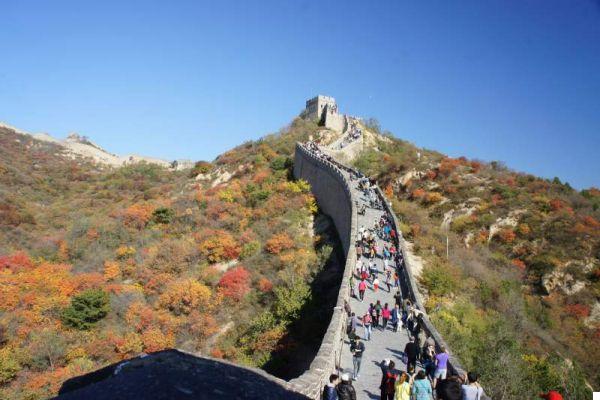
Badaling
The most meticulously restored section of the entire Great Wall of China is also undoubtedly the busiest: most of the organized tour buses (and 75% of tourists!) In fact come here. The restoration work began in 1955 by the then People's Republic of China and the section was opened to the public in 1957.
Badaling it has also been the section most visited by VIPs and famous people since then: visiting US presidents have come here, big names like Richard Nixon, Jimmy Carter, Ronald Reagan, George Bush and more recently President Obama.
Today the "Northern Pass" is also rentable and many foreign companies organize events and demonstrations here.
Built on a strategic mountain pass north of Beijing (hence the name "Northern Pass") this section of the Great Wall of China is one of the best views and offers excellent visibility for many miles as well as being the most easily accessible and therefore suitable for families with children and people with reduced mobility.
From the main entrance, the section can be walked both to the right and to the left, but if you want to avoid the queues, the left side (the one to the north) is better: here it is easier to avoid the crowds, the stalls and the sellers of water and souvenirs.
Mutianyu (慕田宇)
La Mutianyu section della Muraglia is the alternative to Badaling, but less touristy even if here year after year the stalls and vendors grow visibly. This section is also well restored and has fantastic views: the wall winds up to the top of a mountain before descending again, forming a triangle in the shape of an ox horn and therefore renamed "the horn".
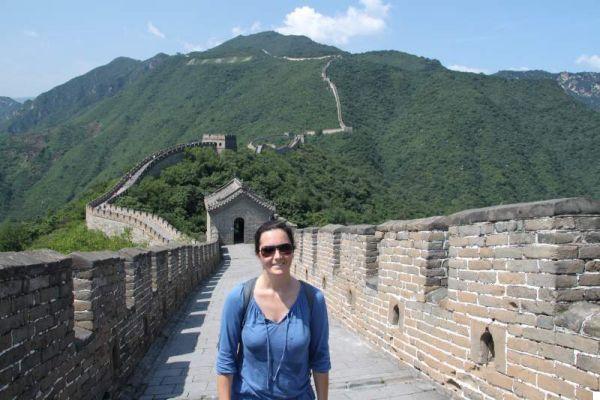
A snapshot of me during the visit of Mutianyu
Unfortunately Mutianyu, although not at the levels of Badaling, is quite touristy. To avoid the crowds instead of the main section there is another one which is located about 30 miles / 50 km east of Badaling although more difficult to reach from Beijing which is about 70 km away.
Reopened in 1986, the Mutianyu section has a cable car to get to the top and a fun toboggan has been set up to go down the mountainside to the road.
In the end I chose this section of the wall because I was looking for a good compromise between the small crowd and the great beauty of the views. Furthermore, Mutianyu has been excellently restored and rebuilt exactly as it should have been originally, in granite and brick, up to 7 meters high and 4 meters wide and crenellated for much of its length.
In this video edited by Amazing Places on our Planet all the beauty of the entire Mutianyu path can be observed.
Simatai (Simatai)
Although farther from Beijing than Badaling and Mutianyu, the sections of Simatai e Jinshanling they are very little touristy and here the crowds of tourists are really hard to find. Some say that these two sections of the wall are much more fascinating than the others, but it is not feasible for everyone: the section of Simatai (5 and a half km long) has areas with really steep and tiring stairways and people with reduced mobility or with children may have some problems walking it all.
Even in the uphill section known as the "Starway to Heaven" it is necessary to proceed on all fours to climb a slope that touches 70%, and in other points it is necessary to pay close attention to where you put your feet such as in the 100 meters known as the "Sky Bridge".
The most scenic part of the whole section is however the stone overpass and the stairs leading to the “Tower of the fairies”.
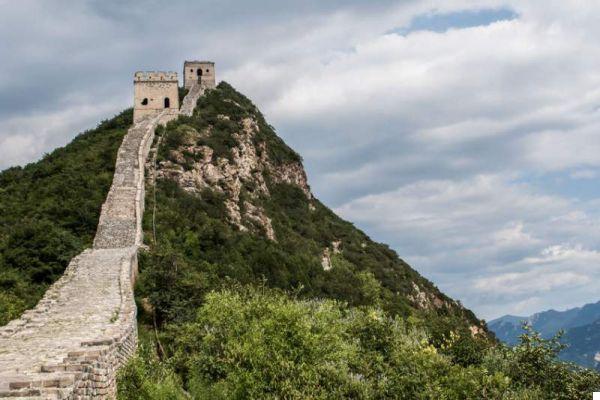
Simatai
The Simatai section begins at the Simatai Reservoir (the Simatai artificial lake) and all the way the wall extends in long snakes that wind along the ridges of the mountains, sometimes with deep gorges on both sides and in some places it is it is necessary to proceed in single file. Despite the recent restoration work that involved not a remaking of the wall but a reinforcement, Simatai has preserved its original appearance and here you can feel its true historical atmosphere.
However, if you want to visit Simatai you have to book. Yes, because for safety reasons the number of visitors is limited. You can book first on the internet on this site (in Chinese!) one to ten days in advance using an identity document such as a passport. When you arrive at the ticket office you must present your confirmation and your document. For those who do not book in advance, theentrance is not guaranteed.
Jinshanling (金山岭)
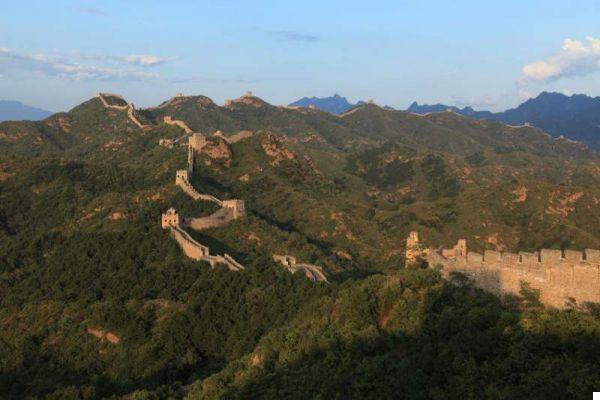
Jinshanling
One of the most distant and difficult to reach, the section of Jinshanling it is located about 150 km from Beijing and is by far the most recommended for those looking for an "authentic" experience despite not having undergone renovations yet, the wall here is well preserved and after Badaling it is the most complete section.
With a length of about 10 km, Jinshanling has very well preserved structures, and the towers here are among the best for observing the Ming architectural styles: there are in fact 67 towers in three different shapes: square, round while those at the corners have a strangely "angular" shape.
The most famous tower of all is undoubtedly the "warehouse tower" renamed in this way as there is a storage unit located on the south terrace.
Here too, although it is better to bring some snacks and plenty of water, unfortunately there are vendors and stalls selling drinks and souvenirs.
For those who really want something different, little known and very little frequented, by far the best choices are Jiankou e Zhuangdaokou.
However, it must be borne in mind that these sections of the Wall are not restored, many parts have collapsed and crumbled and they can be dangerous if you don't walk with some attention.
If nothing else, however, here one appreciates the serenity of having the Wall only (or almost) all to oneself.
Warning! Once it was possible to travel in full Simatai West until you reach Jinshanling in about 5 hours of walking. Apparently this route was really very fascinating, but today it is no longer possible: before reaching the Simatai Reservoir, a check-point forbids you to continue.
Jiankou (Jiankou)
For lovers of nature, trekking and photography, no part of the Wall is better than the dramatic, difficult and demanding Jiankou.
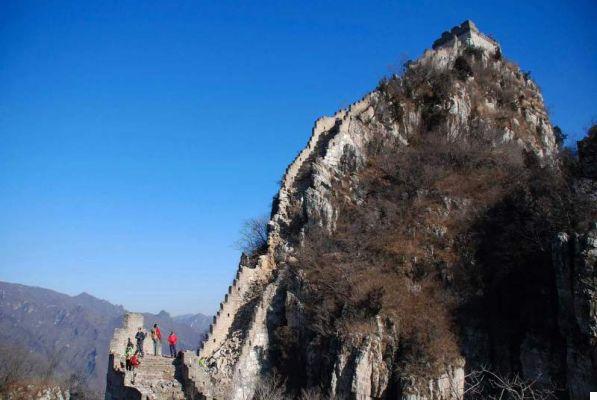
One of the steepest parts of Jianku credit http://www.absolutechinatours.com
Renamed La Wild Chinese Wall, Jiankou is known as the most charming and picturesque section of all.
The main section was built along a ridge with steep cliffs on both sides and walking along it requires good physical shape and great attention: now only sketchy ladders, steep climbs, crumbling stones and bushes blocking the road, Jiankou is the section where definitely go if you love adventure and things out of the ordinary.
If I had known at the time of the existence of this section of the Great Wall I would have come here without a doubt.
It is located near the Xizhaizi village about 70 km from Beijing and the best way to get there is by taxi or with a tour organized by local agencies.
Unlike other brick sections such as Mutianyu, the wall here was built with the local material, dolomite.
It is made up of 28 towers whose most popular and well known are the Nine-Eye Tower, the Beijing Knot and Sky Star. One section in particular, the 38 Giant Steps is among the steepest of the wall with an inclination of 80 degrees and is the most difficult and dangerous part: to follow it, harnesses and climbing ropes are necessary if not essential.
To appreciate the sunset the best place is the Zhengbeilou Tower.
Zhuangdaokou
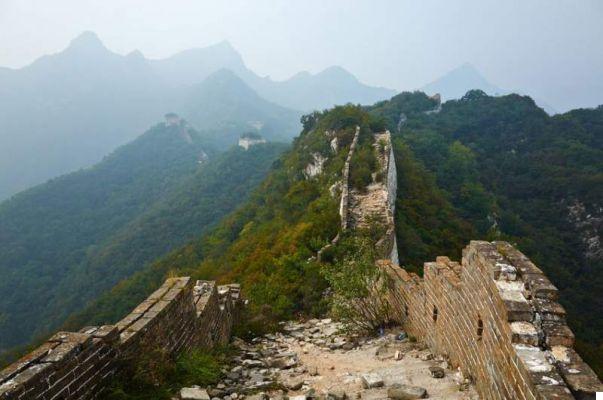
Unlike the other sections that are built with stones that were recovered on site, this section was built with everything that could be found in the area: stacked stones, beaten earth bricks and so on and so forth.
For this reason, Zhuangdaokou has earned the nickname "Museum of the Great Walls". Here we walk in silence. The wall takes its name from the small village that has no particular attractions in itself if it is not a village where tourists are very few.
Avoid the crowd, the factors to consider
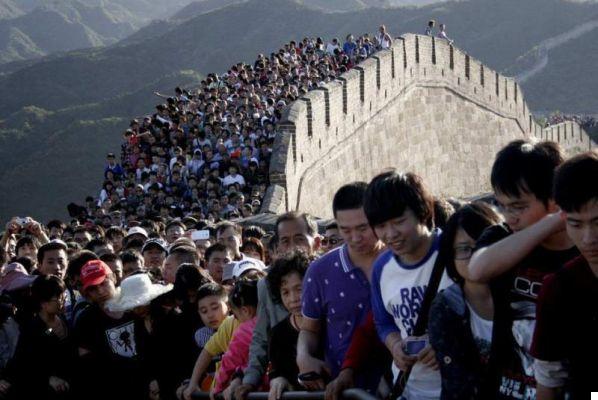
Badaling on a holiday credit Thrifty Nomads
If you are a small group, renting a taxi is a good choice as it allows you to visit several sections of the wall in one day. The price varies a lot, the best is to contact
a taxi driver directly and bargain (be careful, inquire about the numbers if not, do the end that I did).
However, every hotel and hostel is able to organize your trip or call a taxi.
Most of the tourism in China is domestic. The Chinese prefer to participate in tours organized by agencies and often travel en masse with large buses: the Badaling section it is the most popular of all and it is absolutely to be avoided if you do not want to find yourself in the middle of a shouting and intrusive crowd.
On the other hand, Badaling, in addition to being renovated very well, is also very easy to walk and suitable for everyone and the scenery that can be enjoyed from up there is undoubtedly one of the best.
Since the majority of tourists are Chinese, it is better to avoid weekends and holidays, as well as summer days, like the plague.
But if it is really inevitable to go there these days, it is better to arrive on the wall very early in the morning or late in the evening: this also improves the opportunities to take home some beautiful photographs, because the light is better.
How to get to the Chinese wall from Beijing
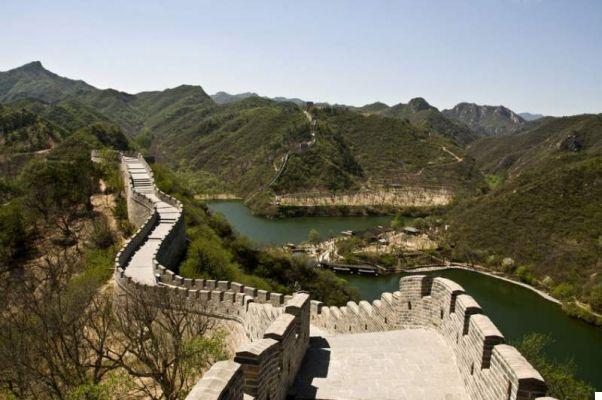
Peace of Huanghua Cheng section
If you have any doubts about how to get to the chosen section of the Chinese Wall, you can still take part in a day tour organized by some agency.
But in this way you lose the pleasure of getting lost as it happened to me who chose the bus and ended up wandering aimlessly in the middle of the Chinese countryside and climbing up and then getting off the buses at each successive station shouting at the top of my lungs "c ' is anyone here who speaks english?!? " and observing the startled faces of the Chinese who looked at me as if I were a fool to lock up in some prison and throw away the keys.
With the exception of Badaling and Mutianyu, a bus trip to any other of the sections requires at least more than 2 hours one way and involves changing buses. Put simply, it's not easy. Some bloggers have also reported that the drivers made them get off at the wrong stops, thus forcing them to take the taxi with which they were evidently already in cahoots.
Some sections of the Wall are very far to reach so it is advisable to spend a night here. For example backpackers can camp in Jinshanling or find some cheap hotels around Simatai. Some agencies like for example Cycle China o China Hiking they organize two-day trips both in camping and with overnight stays in the villages near the various sections.
One tip: make sure you have the names of where you need to go in Chinese. Most drivers don't speak English, so showing them a ticket with their name written in Chinese is a great way to make yourself understood.
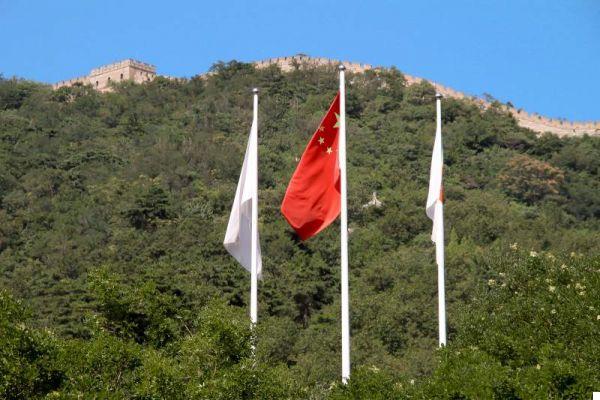
Another snapshot during our visit to Mutianyu
Public transport (Bus)
How to get to Badaling:
There are several ways to get to Badaling by public transport including the train, but the best option is to take the Badaling Great Wall Bus No.877 which starts from station of the
bus di Deshengmen.
Deshengmen station is chaotic and full of people including touts who try to stop tourists and take them with their vans and their organized groups: however insistent they may be, go ahead, better not give in and take the bus. Better to arrive at the station very early and try to get to Badaling as soon as possible so as to avoid finding a long line of people on the wall.
How to get to Mutianyu:
Unlike Badaling, there is not always a direct bus from Beijing to Mutianyu, but you have to change.
Pay close attention to the information you find: I followed an outdated guide and got lost, wandering around on buses in the middle of the Chinese countryside for hours before I managed to get to the Wall.
The bus you have to take is the bus 916 Express from Dongzhimen station (located on metro lines 2 and 13) and you have to get off at the Beidajie stop in the Huairou district. From Huairou you can choose: either take the local buses H23 or H24 or take a taxi.
Alternatively there is the # 936 which leads directly to Mutianyu from Beijing ma which does not do service all year round.
How to get to Simatai:
Buses to Simatai also depart from Dongzhimen Station and are the 980 or 980 Express. You have to get off the bus at Miyun station and take buses Mi 37, Mi 50, or Mi 51 to Simatai village.
How to get to Jinshanling:
From the Dongzhimen station where the bus to Mutianyu also leaves, you have to take the bus 980 which stops in Miyun: from here you then take a minibus. Jinshanling can be reached via the Jinshanling Tunnel: once you arrive at the car park, you can take the cable car to the Lesser Jinshan Tower, or walk up one of the many paths.
How to get to Jiankou:
Getting to Jiankou by public transport is an odyssey. Your best bet is to hire a taxi or join some organized groups.
However, if you really want to embark on this journey of hope, to get to the Jiankou Wall you can take the bus 936 always at the Dongzhimen station, get off at Yujiayuan and then you can either get to the village of Xizhazi with the local bus H25.
There are actually three ways to get to Jiankou: by bus from the village of Xizhazi, from Wofo Mountain Villa which is located near Mutianyu and from Mutianyu itself continuing the journey on the Wall.
How to get to Zhuangdaokou:
From Dongzhimen station take thebus 916 up to Huairou and then go down, walk two blocks and take the one to Changcheng. You have to ask the driver that you want to get off at Zhuangdaokou.
Warning! Once you arrive in Huairou people will ask you where you want to go and if you say you want to go to Zhuangdaokou they will tell you that there are no buses to convince you to get on one of their mini-vans. Pay no attention to it.
Organized tours
If you don't want to take the bus or the train there is the opportunity to participate in some organized tour. There are tours for all tastes and budgets: tours that include transport only, tours with an English-speaking guide, photo tours, bike tours, tours that also include stops during the day and visits to museums, to Ming tombs and to factories and souvenir shops.
Unfortunately, having not participated in any of these organized tours, I have no agency that I can advise you personally, my only advice is not to choose a tour only based on the lowest price, but to evaluate different proposals. Tours are organized not only by specialized agencies, but also by hostels (such as the Beijing Downtown Backpackers) and hotels.
Some agencies recommended by travelers (if you know any others let me know in the comments!):
Wild Great Wall Adventures
Cycle China
China Hiking
Beijing Sideways (who organizes sidecar tours)
China Highlights
If you are only interested in transport you can also negotiate the price of the day with the taxi drivers to pick you up at your hotel and take you back.
Some advice (learned from my mistakes)
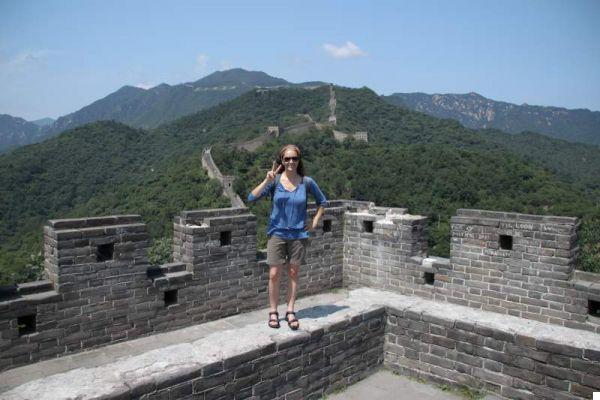
From lack of water to not having brought toilet paper… what have I learned from my mistakes?
Bring lots and lots of water although in practically all sections of the wall you will find someone who sells it to you at a price ten times higher than if you buy it in Beijing. The other side of the coin is that if you buy it on the wall you will find it fresh.
In any case, whichever section you choose to put comfortable shoes it is a must as you will walk for hours.
If you choose an area that is more difficult to reach, that is, those less crowded and with public transport, seriously consider stopping and spending a night out of town: you will find accommodation wherever you are.
If you choose one of the unrestored sections, really consider doing atravel insurance (I recommend viaggisicuri.com) to avoid breaking your ankle and ending up in a Chinese hospital.
What to bring: sports or hiking shoes, sticks, cap, sunglasses, sunscreen, water bottles, snacks, pocket knife, lip balm and first aid kit.
If possible, use the bathrooms at the entrance to the various sections of the wall: there are no toilets along the paths.
Unfortunately many people use the towers as a bathroom and when you walk through them you can hear them. Bring some toilet paper, a hand soap or sanitizer because in the bathrooms they are not always available.
Better to wear long pants even in summer especially if you visit the parts of the Wall that have not been restored and where bushes (and insects!) are the masters.
Be responsible hikers taking only your beautiful photographs with you from the wall and leaving nothing there but your footprints.
In summary, therefore, to avoid the crowds on the Chinese Wall it depends on the period in which you go, but above all on which section you choose: in any case, with crowd or without crowd, in Badaling or Mutianyu, in short, whatever you choose I assure you that it will be worth it. penalty.




